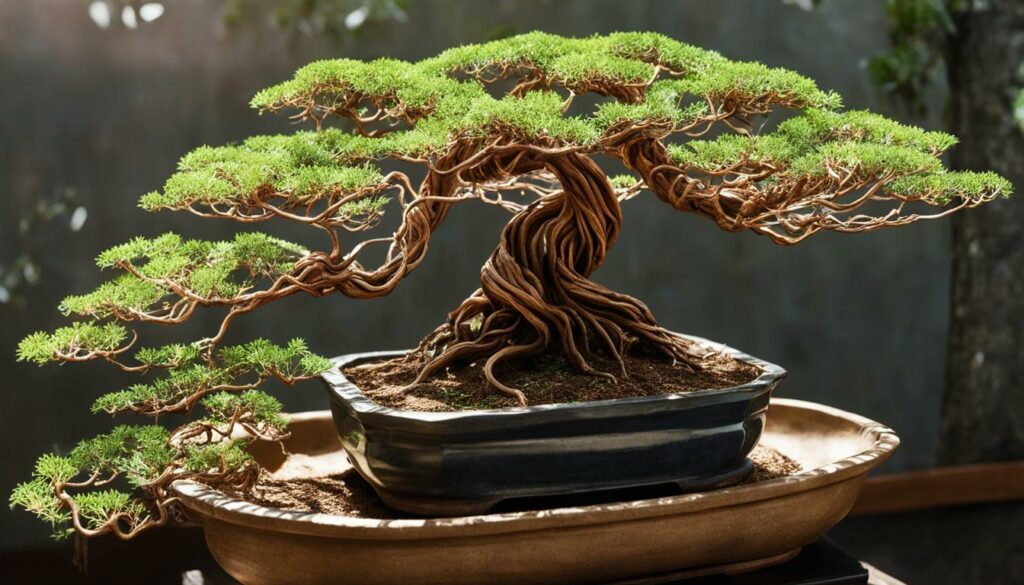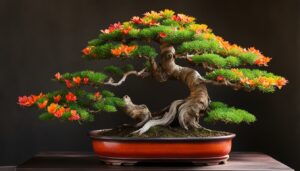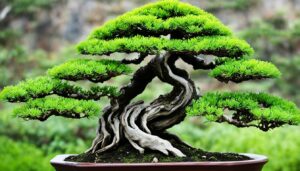Welcome, bonsai enthusiasts! Have you ever marveled at the intricate shapes and designs of bonsai trees and wondered how they achieve such stunning results? Look no further than the practice of bonsai styling wiring. Wiring is a crucial technique in shaping and designing your bonsai trees while promoting their health and longevity. In this comprehensive guide, you will discover the materials, techniques, and principles behind bonsai styling wiring, taking your tiny trees from ordinary to extraordinary.
Key Takeaways
- Wiring is a practical and artistic technique for shaping and designing your bonsai tree.
- Using the appropriate materials and techniques are essential for successful wiring.
- Proper preparation of the tree and knowledge of branch shaping and bonsai design are crucial considerations for effective wiring.
- Effective maintenance, patience, and timing are vital for the health and longevity of your bonsai trees.
- Mastery of bonsai styling wiring can elevate your overall bonsai skills and enhance your designs.
Understanding Bonsai Styling Wiring
Before you can dive into the techniques of bonsai styling wiring, it’s essential to understand the concept and purpose behind it. Bonsai styling wiring is a technique used to shape and train branches of a bonsai tree, creating the desired design and aesthetic. It involves wrapping wire around the branches, which provides support as the branches are bent and shaped into the desired form. The wiring process influences the direction of growth, allowing you to create an aesthetically pleasing and healthy bonsai tree.
Wiring is an essential skill that every bonsai enthusiast must understand to create authentic and natural-looking designs. It is a technique that has been used for centuries and continues to be an integral part of the art of bonsai. By understanding the history and philosophy of bonsai styling wiring, you can appreciate the nuances of this delicate art form.
The Philosophy of Wiring Bonsai Trees
Wiring bonsai trees is not just about creating an attractive design but also about fostering a deeper connection with nature. It is an act of nurturing the tree to achieve a harmonious balance between man and nature. The process of wiring requires patience, care, and attention to detail, all of which help develop a deeper appreciation for the natural world around us.
Choosing the Right Materials for Wiring
Using the right wire is crucial for successful wiring of Bonsai trees. Selecting appropriate thickness and material is important to avoid damage to the tree and ensure successful styling.
There are a variety of high-quality products to choose from, such as aluminum or copper wire, each offering unique advantages. Copper wire is known to be easier to bend and adjust, while aluminum wire is often less expensive and doesn’t corrode as quickly.
When selecting the wire, consider the type of tree you will be wiring. You’ll want to choose a thickness that’s appropriate for the tree’s size and the branch you’ll be wiring. Generally speaking, the thickness should be about 1/3 to 1/2 the diameter of the branch.
It’s also essential that you never use wire that’s too thick, as it can damage the branch or trunk and even lead to the tree’s death.
Wiring Material Comparison
| Material | Pros | Cons |
|---|---|---|
| Aluminum wire | Inexpensive, doesn’t corrode as quickly | Difficult to bend, adjust, and secure |
| Copper wire | Easier to bend, adjust, and secure | More expensive, can corrode quickly |
When choosing wire, ensure that it’s high quality and specifically designed for Bonsai styling wiring. Using low-quality or inappropriate wire can cause damage to the tree and lead to poor results.
Remember, the quality of the wire used will affect the overall health and appearance of your Bonsai tree, so choose wisely.
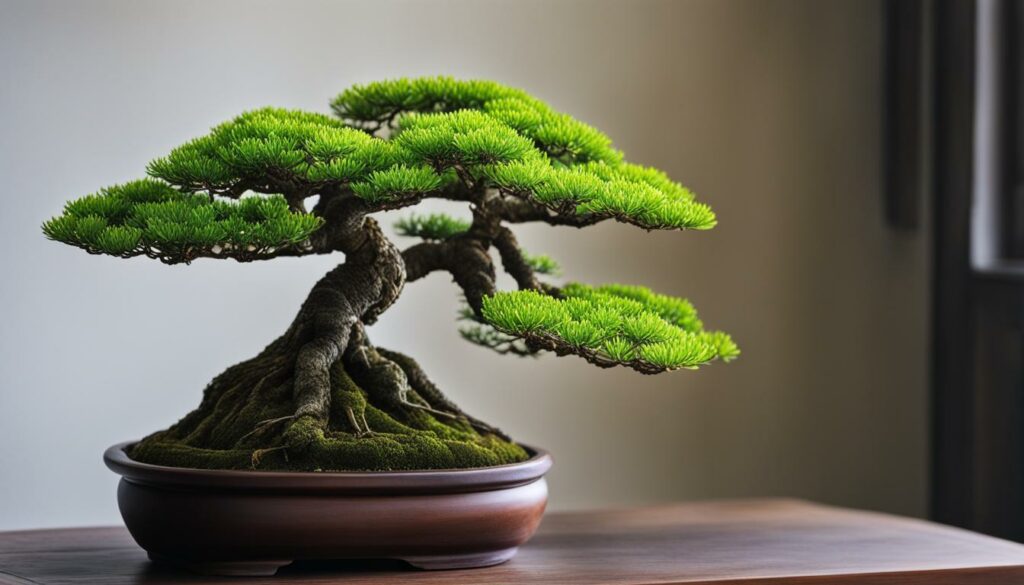
Step-by-Step Wiring Techniques
Wiring is a vital skill in bonsai styling, and the proper technique is critical to achieve the desired results. Here is a step-by-step guide to wiring your bonsai trees effectively and efficiently.
Step 1: Choose the Right Wire
Bonsai Styling Wiring, Wiring techniques Select the appropriate thickness and material for your bonsai tree, ensuring that the wire is strong enough to hold the branches but not so thick that it leaves marks. Cut a length of wire about twice the length of the branch you want to wrap, and then twist it around itself several times to create a sturdy anchor point.
Step 2: Apply the Wire to the Branch
Bonsai Styling Wiring, Wiring techniques Starting at the base of the branch, wrap the wire around it, moving upwards in a spiral fashion. Don’t overlap the wire, but take care not to leave any gaps either. Keep the wire taut while working, but don’t pull it too tightly, or it may damage the branch. Stop wrapping a few millimeters before the tip of the branch, and secure the wire by twisting it around itself as you did in step 1.
Tip: Use a pair of pliers to help twist the wire and make it more secure.
Step 3: Shape the Branch
Bonsai Styling Wiring, Wiring techniques, branch shaping Once the wire is in place, shape the branch to the desired position. Begin at the base of the branch and gently bend it using your fingers or a pair of pliers. Move towards the tip of the branch, taking care not to apply too much pressure. Create the curve or angle you want and then move to the next branch.
Step 4: Remove the Wire
Bonsai Styling Wiring, Wiring techniques Remove the wire after a few months once the branch has set in place. Gently unwind the wire from the branch, taking care not to damage the bark. Inspect the branch for any signs of scarring or damage, and prune it if necessary.
By following these step-by-step wiring techniques, your bonsai trees will thrive and achieve the desired shape and style.
Preparing the Tree for Wiring
Before beginning the wiring process, it’s important to prepare your bonsai tree properly. Proper preparation can prevent damage and ensure successful styling. Below are the best practices for pruning, thinning, and positioning branches.
Pruning
Pruning is the process of removing unwanted branches or foliage from the tree. It’s an essential step in bonsai styling wiring, as it allows for better visibility of the branches and trunk. Before pruning, carefully examine the tree and plan which branches need to be removed. Use sharp pruning shears to make clean, precise cuts at a 45-degree angle. Always make sure to leave enough foliage on the bonsai tree to maintain its health.
Thinning
Thinning involves removing parts of the branch or foliage that are too dense. This helps to avoid wire scarring and allows for better wiring results. Use scissors or needle-nose pliers to remove excess leaves or needles from the branch. Be careful not to remove too much foliage, as it can weaken the tree.
Positioning Branches
Before beginning the wiring process, consider the positioning of the branches. Positioning the branches properly can make the wiring process smoother and more effective. Use wire or string to gently move the branches into the desired position. Be careful not to force the branches too much, as it can cause damage.
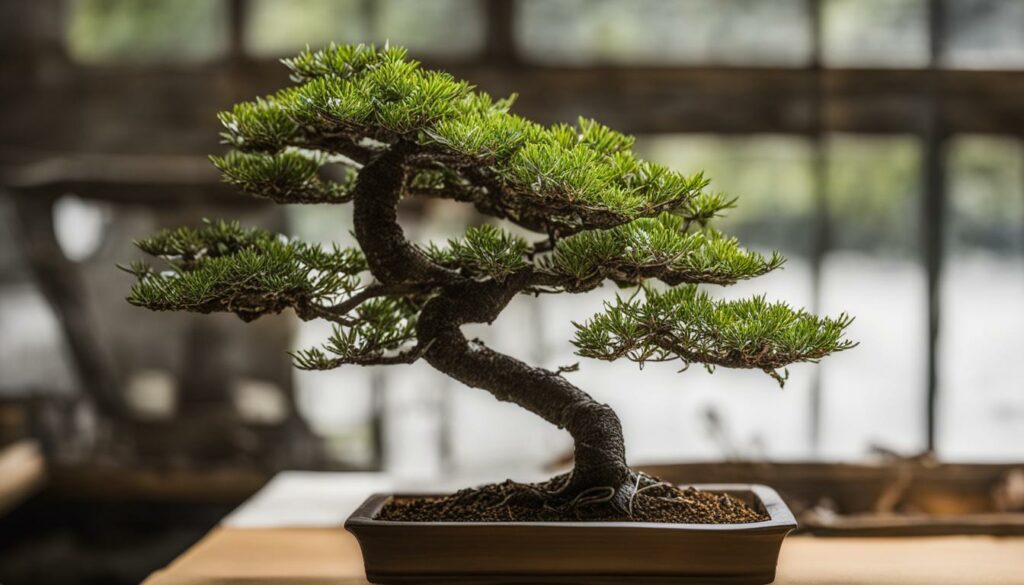
“Proper preparation can prevent damage and ensure successful styling.”
By following these best practices for pruning, thinning, and positioning branches, you can prepare your bonsai tree effectively for wiring. This will help to ensure that the wiring process goes smoothly and achieves the desired results.
Wiring Different Types of Branches
Proper wiring techniques are crucial for shaping and positioning each branch with precision. However, not all branches are created equal when it comes to wiring. Understanding the specific considerations for wiring various types of branches, such as primary branches, secondary branches, and delicate twigs, is essential for achieving successful bonsai styling wiring results. Bonsai Styling Wiring, Wiring techniques, and branch shaping are all necessary concepts to master in order to effectively wire your bonsai tree.
For primary branches, it’s important to select wire that is strong and thick enough to hold the weight and position of the branch. When wiring secondary branches, consideration must be given to their size and location on the tree. Delicate twigs are particularly challenging to wire, and require extra care and attention to avoid damaging the branch or bark.
- Clean and prepare the branch for wiring, ensuring that it is free from leaves and debris.
- Select the appropriate wire thickness and material for the specific branch.
- Begin by wrapping the wire loosely around the branch, taking care not to damage the bark.
- Gradually tighten the wire, using pliers to create curves and angles as desired.
- Check the wire regularly to ensure that it is not damaging the branch or cutting into the bark.
Remember that wiring is only one aspect of branch shaping. In addition to wiring, proper pruning and positioning of branches is necessary to achieve the desired overall design. With practice and attention to detail, you can master the art of wiring bonsai trees.
Wiring the Tree’s Trunk
The trunk is the backbone of your bonsai tree, providing visual structure and balance. To achieve the desired shape, movement, and taper, it’s important to master the art of trunk wiring. Here are some techniques and principles to keep in mind:
Create Movement:
Wiring the trunk allows you to create gentle curves or more drastic bends, giving the tree a natural flow and movement. Begin at the base of the trunk and work your way up, wrapping the wire around the trunk in a spiral pattern. Use wire that is roughly one-third the thickness of the trunk.
Achieve Taper:
One of the most challenging aspects of trunk wiring is creating a taper, whereby the trunk becomes thinner towards the top. Keep in mind that the wire should be wrapped loosely and should not cut into the bark.

Tip: When wiring, be mindful of the buds and nodes on the trunk, as they will dictate the direction of the new growth.
Balance the Design:
As you wire the trunk and branches of your bonsai tree, ensure that the design is balanced and harmonious. Consider the placement of the branches and how they relate to the trunk and overall proportions of the tree.
“The trunk is the backbone of the bonsai tree. A well-wired trunk provides the design, flow, and balance for the entire tree.” – Bonsai Master
Table:
| Trunk Diameter (in inches) | Wire Thickness (in millimeters) |
|---|---|
| 0-0.25 | 1-1.5 |
| 0.25-0.75 | 2-2.5 |
| 0.75-1.5 | 3-3.5 |
| 1.5-3 | 4-4.5 |
Use this table for reference when selecting the appropriate thickness of wire for your bonsai tree trunk.
Wiring for Bonsai Design
In bonsai styling, wiring is an essential tool used to create beautiful and harmonious designs. By understanding how to wire your tree, you can enhance its aesthetics and overall visual impact. Branch placement is key to creating a well-balanced design. By wiring branches into specific positions, you can create symmetry and flow within your tree.
Consider negative space when wiring your tree. Negative space is the area around the branches that is not occupied by foliage. This space is essential in bonsai design as it contributes to the overall balance and harmony of the tree. By wiring your branches to open up negative space, you can create a sense of depth and dimension within your bonsai tree.
Harmony is another important concept in bonsai design. As you wire your tree, keep in mind the style and character of the tree. Make sure the wiring enhances the tree’s natural beauty, rather than working against it. Creating a harmonious design will make your bonsai tree a stunning work of art.
Wiring is a fundamental part of bonsai design
The Key to Successful Wiring for Bonsai Design
Successful wiring for bonsai design requires careful consideration and planning. Before beginning your wiring work, take time to evaluate your tree and decide on the desired end result. This will help guide your wiring decisions and ensure you create the right shape and style for your tree.
Remember to take a step back and evaluate your wiring from different angles as you work. This will give you a better view of how your design is taking shape and help you make any necessary adjustments.
Enhancing Bonsai Design with Wiring Techniques
| Wiring Technique | Description |
|---|---|
| Branch Shaping | By wrapping wire around branches and positioning them into a specific shape, you can create a well-balanced design and enhance visual impact. |
| Trunk Wiring | Wiring the trunk of the bonsai tree creates movement, taper and balance. It contributes significantly to the overall design and can create a powerful visual statement. |
| Emphasizing Negative Space | By wiring branches in certain positions to open up negative space, you can create a sense of depth, making your bonsai tree appear more expansive and alive. |
Using these wiring techniques, you can create beautiful and well-balanced bonsai designs that are a true masterpiece. The next section will guide you through the steps of maintaining your wired bonsai trees to ensure they continue to thrive with their newly wired design.
Maintaining Wired Bonsai Trees
Now that you have wired your bonsai tree, it is essential to maintain it regularly to ensure its proper growth and health. Here are some techniques for maintaining bonsai styling wiring:
Inspecting the Branches
Regular inspection is necessary to check the condition of the wired branches. Examine the wires for any signs of looseness or biting into the bark. If the wire is too tight or biting, it can cut off the flow of nutrients and water to the branch, leading to damage or death.
Adjusting the Wire
If the branches have grown thicker and have begun to cut into the wire, you will need to remove the existing wire and apply a new one. Furthermore, take care not to overwire the branches, as overwiring can harm the health of your bonsai tree.
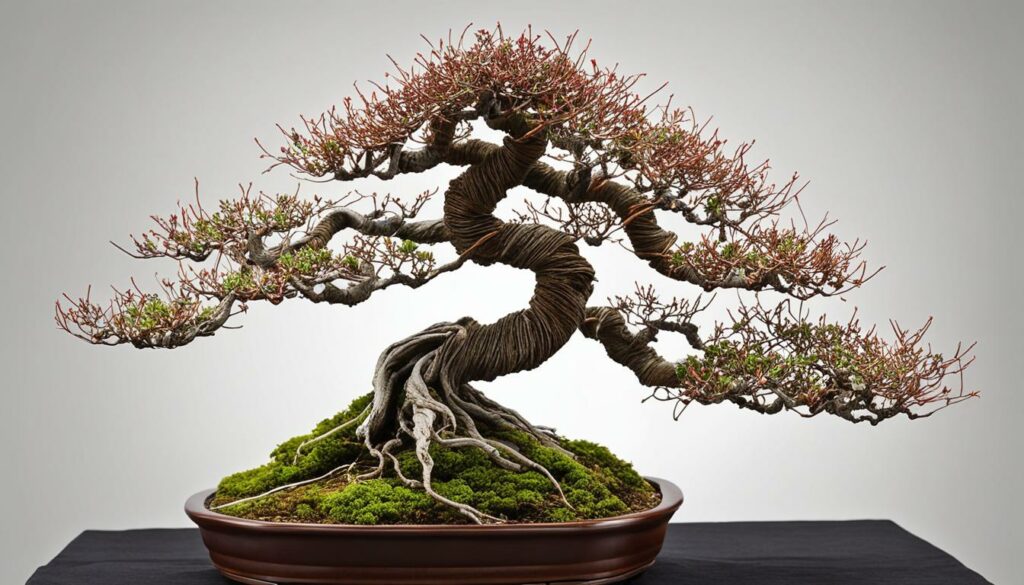
Removing the Wire
When your branches have set in place, and the wire has served its purpose, remove the wire. Leaving the wire on for too long can result in wire scarring. To remove the wire, cut the wire at the end of the branch and use a pair of pliers to unwind the wire. It would help if you did this slowly and carefully, so as not to damage the bark.
Timing is Everything
The timeline of maintenance depends on the growth rate of your tree. Check the wires frequently if it’s a fast-growing tree, while slow-growing trees may not require regular checks.
By following these simple steps, you can achieve a healthy and thriving bonsai tree. Now that you know how to maintain your bonsai tree, it’s time to experiment with different styles and techniques to achieve the perfect design.
The Importance of Patience and Timing
Wiring bonsai trees is an art that requires patience and timing to achieve the desired results. Bonsai Styling Wiring is an art form where every wire placement counts. Rushing into the process can harm the tree and undo the work done thus far. Therefore, patience is critical to avoid any major damage.
Timing is equally important when considering wiring a bonsai. It’s important to wire the tree when it’s at the right developmental stage. Deciding the right time depends on the species of the tree you’re working on and the style of design you have in mind. Wiring work conducted during the wrong period leads to broken branches and leaves.
Poor timing can also affect the health of the tree. Bonsai trees require time to recover after a session of wiring and reshaping. Rushing into the next session before anatomical recovery can harm the tree and reduce its longevity.
Take time to research and understand the different timing and patience requirements before starting on the process of wiring your bonsai tree. Remember, great things come to those who wait.
Troubleshooting Common Wiring Issues
Wiring bonsai trees can be a delicate process, and even experienced enthusiasts may encounter common issues. Understanding these issues and implementing preventive measures can help you avoid potential complications and ensure the success of your wiring project.
Wire Biting
One common issue when wiring bonsai trees is wire biting. This happens when the wire is too loose and allows the branch to move, causing the wire to dig into the bark and cut off the tree’s nutrient flow. To avoid this, ensure the wire is wrapped tightly around the branch, leaving no gaps between the wire and the bark.
Scarring
Another concern is scarring, which occurs when the wire is left on the tree for too long. To prevent scarring, inspect the wire regularly and remove it once the branch has set in place. Alternatively, consider using a softer wire or a protective layer such as raffia to cushion the branch from the wire’s pressure.
Wire Digging into the Bark
Wire digging into the bark can also be an issue, especially when wiring young and delicate branches. One way to prevent this is by using smaller diameter wires that are more flexible and less likely to leave marks.
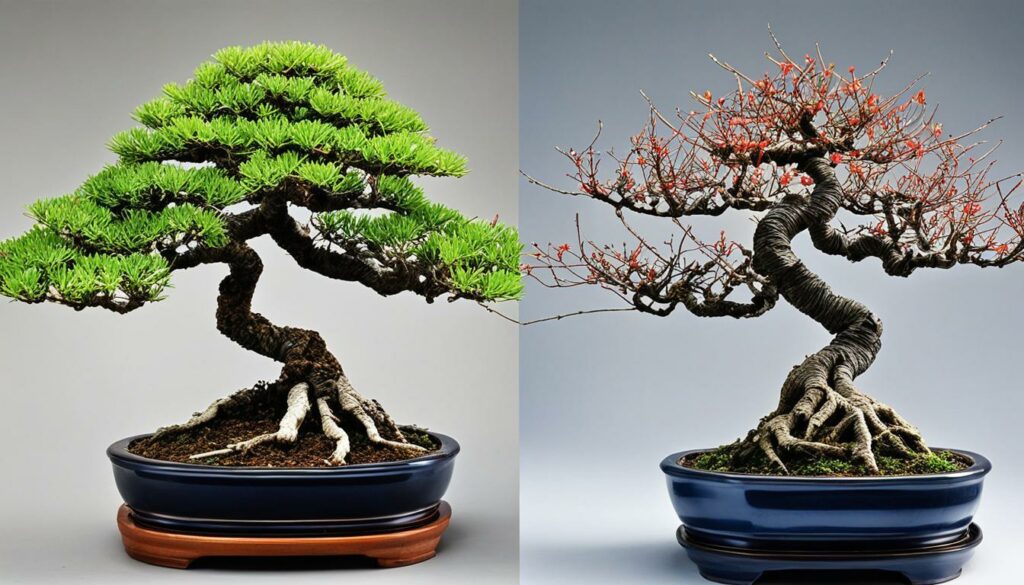
“Inspect your wired tree regularly, and adjust or remove the wire as needed to avoid potential issues. Remember that proper maintenance is critical for the health and longevity of your bonsai tree.”
Take care when wiring your bonsai trees, paying close attention to the materials, techniques, and timing. With patience, precision, and knowledge of potential issues, you can complete a successful wiring project and take your bonsai styling to the next level.
Enhancing Your Bonsai Skills with Wiring
By mastering the art of Bonsai Styling Wiring, you can take your bonsai journey to new heights. Not only is wiring a practical skill, but it also allows for intricate and captivating branch shaping to achieve your desired bonsai design.
To enhance your wiring abilities, it’s essential to explore various resources and techniques. Consider joining a bonsai club or attending workshops and lectures to learn from experienced artists. Online forums and instructional videos can also provide valuable insights and tips.
Practice is essential when it comes to bonsai styling wiring. Continuously challenge yourself by working with different types of trees and branches, experiment with new wiring techniques, and incorporate wiring in creative ways to achieve your desired bonsai design.
Remember to be patient, as wiring requires time and careful consideration. Enjoy the process and the artistry behind bonsai styling wiring, and continue to enhance your skills with each tree.
Conclusion: Transform Your Bonsai Trees with the Art of Wiring
Congratulations! You’ve made it to the end of this essential guide to bonsai styling wiring. By now, you should have a comprehensive understanding of the techniques, materials, and principles behind wiring bonsai trees.
Remember that wiring is not only a practical skill but also an artistic one. With the ability to shape and position branches with precision, wiring is a fundamental part of bonsai design. By enhancing your wiring abilities, you can take your bonsai journey to new heights and create more intricate and captivating designs.
As you begin your wiring journey, keep in mind the importance of patience and timing. Wiring is a delicate process that requires time and attention to detail. By allowing the tree to recover and adjust after wiring, you can ensure its health and longevity.
If you encounter any common wiring issues along the way, don’t worry! Troubleshooting techniques and preventive measures can help you overcome these challenges.
Overall, wiring is an essential practice in bonsai styling that allows for the transformation of small trees into captivating living sculptures. With your newfound knowledge and skills, you can unlock the true potential of your bonsai trees and create stunning works of art.
Thank you for reading this guide, and happy wiring!
FAQ
What is the purpose of bonsai styling wiring?
Bonsai styling wiring is used to shape and position the branches and trunk of a bonsai tree, allowing for the creation of desired forms and designs. It helps achieve the aesthetic vision of the bonsai artist and contributes to the overall beauty and balance of the tree.
What are the different types of wire used for bonsai styling wiring?
There are various types of wire available for bonsai styling wiring, including aluminum wire and copper wire. Aluminum wire is commonly used for deciduous trees due to its flexibility and ease of use. Copper wire is preferred for coniferous trees as it provides more strength and holds branches in place better.
How do I choose the right wire thickness for my bonsai tree?
The choice of wire thickness depends on the thickness and strength of the branch or trunk you intend to wire. Generally, the wire should be about one-third the thickness of the branch or trunk. Using a wire that is too thin may not provide enough support, while using a wire that is too thick can damage the tree.
What is the correct way to wrap wire around branches and trunk?
When wiring branches, start by wrapping the wire at a slight angle, gradually moving upward or downward along the branch. Make sure to leave enough space between each wrap to avoid excessive pressure on the bark. For the trunk, wrap the wire in a helical pattern, ensuring it is snug but not too tight.
How long should the wire be left on the tree?
The wire should be left on the tree for a sufficient period to allow the branches to set in the desired position. This varies depending on the growth rate of the tree and the thickness of the branches. It is generally recommended to check the wire regularly and remove it once the branches have set but before it starts digging into the bark.
Can I reuse wire that has been removed from a bonsai tree?
Reusing wire is possible if it is in good condition and hasn’t been severely bent or damaged during removal. However, it is generally recommended to use fresh wire for each wiring session to ensure optimal strength and effectiveness.
